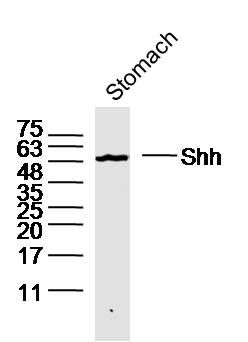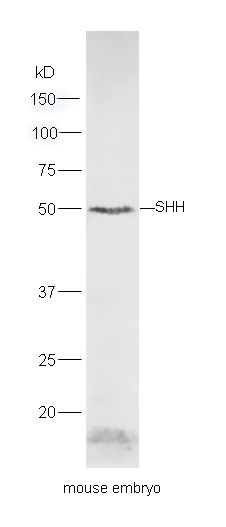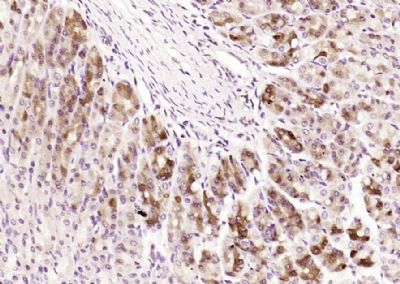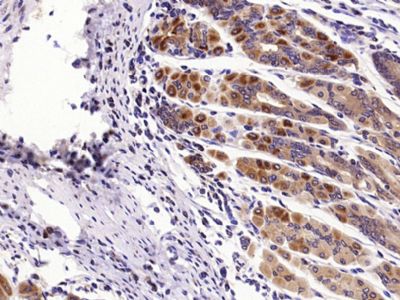[IF=4.2] Yang, Huan, et al. "Vitamin C plus hydrogel facilitates bone marrow stromal cell-mediated endometrium regeneration in rats." Stem Cell Research & Therapy 8.1 (2017): 267. WB ; Human.
[IF=8.718] Chao Sun. et al. WISP-1 induced by mechanical stress contributes to fibrosis and hypertrophy of the ligamentum flavum through Hedgehog-Gli1 signaling. Exp Mol Med. 2021 Jun;53(6):1068-1079 WB ; Human.
[IF=4.183] Takebe H et al. Sonic Hedgehog Regulates Bone Fracture Healing. Int J Mol Sci. 2020 Jan 20;21(2). pii: E677. IHC ; Rat&Mouse.
[IF=3.396] Guo Q et al. Baicalin improves the in-vitro developmental capacity of pig embryos by inhibiting apoptosis, regulating mitochondrial activity and activating sonic hedgehog signaling. Mol Hum Reprod. 2019 Sep 1;25(9):538-549. IHF ; Pig.
[IF=2.35] Bai, Yongheng, et al. "Sonic hedgehog-mediated epithelial-mesenchymal transition in renal tubulointerstitial fibrosis." International journal of molecular medicine 37.5 (2016): 1317-1327. IHSLCP ; Rat.
[IF=2.47] Ma, Tao-tao, et al. "Geniposide alleviates inflammation by suppressing MeCP2 in mice with carbon tetrachloride-induced acute liver injury and LPS-treated THP-1 cells." International Immunopharmacology (2015). WB ; Human.
[IF=2.15] Fan, Hai-Xia, et al. "Sonic hedgehog signaling may promote invasion and metastasis of oral squamous cell carcinoma by activating MMP-9 and E-cadherin expression." Medical Oncology 31.7 (2014): 1-8. IHSLCP ; Human.
[IF=4.56] Wang, H., et al. "Baicalin Attenuates Alcoholic Liver Injury through Modulation of Hepatic Oxidative Stress, Inflammation and Sonic Hedgehog Pathway in Rats." Cellular Physiology and Biochemistry 39.3 (2016): 1129-1140. WB ; Rat.
[IF=2.74] Qing Guo. et al. Paeoniflorin improves the in vitro maturation of benzo(a)pyrene treated porcine oocytes via effects on the sonic hedgehog pathway. Theriogenology. 2022 Mar;36:72 IF ; Pig.
[IF=8.98] Weiss, Robert M., et al. "Brg1 Determines Urothelial Cell Fate during Ureter Development." Journal of the American Society of Nephrology: JASN (2013). other ;
[IF=3.361] Chen X et al. Hesperetin derivative attenuates CCl4-induced hepatic fibrosis and inflammation by Gli-1-dependent mechanisms. Int Immunopharmacol. 2019 Aug 29;76:105838. WB ; Mouse.
[IF=3.118] Lin X et al. Geniposide, a sonic hedgehog signaling inhibitor, inhibits the activation of hepatic stellate cell. Int Immunopharmacol. 2019 Apr 18;72:330-338. WB ; Mouse&Rat.
[IF=3.7] Wu, Xiaoqin, et al. "Melittin induces PTCH1 expression by down-regulating MeCP2 in human hepatocellular carcinoma SMMSLC7721 cells." Toxicology and Applied Pharmacology (2015). WB ; Human.
[IF=4.46] Du, Wen‐Zhong, et al. "Curcumin Suppresses Malignant Glioma Cells Growth and Induces Apoptosis by Inhibition of SHH/GLI1 Signaling Pathway in Vitro and Vivo." CNS Neuroscience & Therapeutics (2013). WB ; Human.



